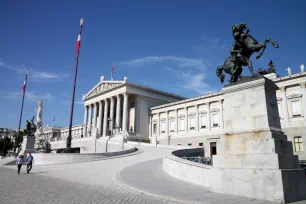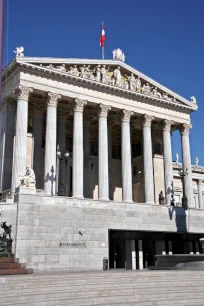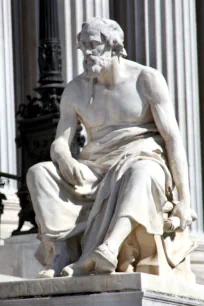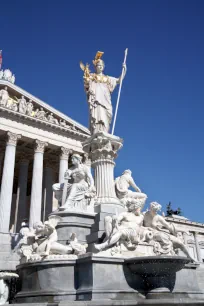One of the main eye-catchers along the Ringstraße – the boulevard around Vienna’s inner city – is the Parlament. The monumental Neoclassical building is the seat of the Austrian Parliament.
Construction

After the old city walls were torn down during the mid-nineteenth century, a grand boulevard was created around the historic center of Vienna. Soon, monumental buildings were erected along the boulevard, known as Ringstraße. Five of those buildings were designed by Theofil von Hansen, of which the Parlament is the most monumental. Hansen had studied architecture in Athens, and the Greek influence clearly shows in his design for the Austrian Parliamentary Building. The Neoclassical architecture is an obvious reference to Ancient Greece, the cradle of democracy.



The Austrian Parliament
The Parliament building was constructed between 1874 and 1884 as the seat of the Reichsrat, the Imperial Parliament representing the Austrian part of the Austro-Hungarian monarchy. Inside are two large assembly halls, which originally housed the two chambers of the Imperial Parliament: the Herrenhaus (upper house) and the Abgeordnetenhaus (lower house).
In 1918, after the fall of the Habsburg Empire, parliamentarians declared the creation of the Republic of Austria. Today, the building houses sessions of the Nationalrat (National Council) and the Bundesrat (Federal Council).
The Design
The imposing structure is dominated by the central portico with eight monumental Corinthian columns. Sculptures on the tympanum depict Franz Joseph, who grants his subjects a constitution. Wide ramps lead to the portico.
At the foot of the ramps are statues of Horse Tamers. Eight more statues on the balustrades show historians from the Antiquity: four Greek historians on the left ramp and four Roman historians on the right ramp. The building is decorated on all sides with many more statues and friezes (together more than one hundred) and four sculpture groups of chariot riders adorn the roof of the Parlament.
Pallas-Athene-Brunnen
The Greek theme is continued with the Athenebrunnen, a monumental fountain in front of the Parliament Building, named after the Greek goddess Pallas Athena – goddess of wisdom – who is portrayed with a colossal statue on top of a fluted column.
Below her are two female statues, representing the legislative and executive powers of the state. At the base are four allegorical statues of the four most important rivers of the Austro-Hungarian Empire: the Danube and the Inn in the front and the Elbe and the Vltava in the back. The fountain, which was unveiled in 1902, was created by sculptors Carl Kundmann, Josef Tautenhayn and Hugo Haerdtl.
- Next: Hoher Markt
- More Sights & Attractions in Vienna

